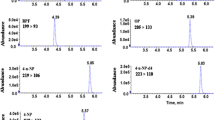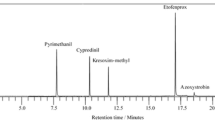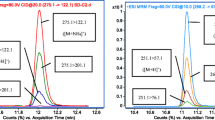Abstract
An improved analytical method enabling rapid and accurate determination and identification of bisphenol F diglycidyl ether (novolac glycidyl ether 2-ring), novolac glycidyl ether 3-ring, novolac glycidyl ether 4-ring, novolac glycidyl ether 5-ring, novolac glycidyl ether 6-ring, bisphenol A diglycidyl ether, bisphenol A (2,3-dihydroxypropyl) glycidyl ether, bisphenol A (3-chloro-2-hydroxypropyl) glycidyl ether, bisphenol A bis(3-chloro-2-hydroxypropyl) ether, and bisphenol A (3-chloro-2-hydroxypropyl) (2,3-dihydroxypropyl) ether in canned food and their contact packaging materials has been developed by using, for the first time, ultra-performance liquid chromatography coupled with tandem mass spectrometry. After comparison of electrospray ionization and atmospheric pressure chemical ionization in positive and negative-ion modes, tandem mass spectrometry with positive electrospray ionization was chosen to carry out selective multiple reaction monitoring analysis of novolac glycidyl ethers, bisphenol A diglycidyl ether, and its derivatives. The analysis time is only 5.5 min per run. Limits of detection varied from 0.01 to 0.20 ng g−1 for the different target compounds on the basis of a signal-to-noise ratio (S/N) = 3; limits of quantitation were from 0.03 to 0.66 ng g−1. The relative standard deviation for repeatability was <8.01%. Analytical recovery ranged from 87.60 to 108.93%. This method was successfully applied to twenty samples of canned food and their contact packaging materials for determination of migration of NOGE, BADGE, and their derivatives from can coatings into food.




Similar content being viewed by others
References
Berger U, Oehme M, Girardin L, Fresenius J (2001) Anal Chem 369:115–123
Xue M, Zhang H (2009) Food Res Dev 30(7):169–173
Satoh K, Ohyama K, Aoki N, Iida M, Nagai F (2004) Food Chem Toxicol 42:983–993
Garcia RS, Losada PP (2004) J Chromatogr A 1032:37–43
Cottier S, Riquet AM, Feigenbaum A, Pollet B et al (1997) J Chromatogr A 771:366–373
Pardo O, Yusa V, Leon N, Pastor A (2006) J Chromatogr A 1107:70–78
Lintschinger J, Rauter W (2000) Eur Food Res Technol 211:211–217
Poustka J, Dunovska L, Hajslova J, Holadova K et al (2007) Czech J Food Sci 25(4):221–229
Miao JZ, Xue M, Zhang H (2009) Chin J Anal Chem 9(6):911–914
Sun C, Leong LP, Barlow PJ, Chan SH et al (2006) J Chromatogr A 1129:145–148
Leepipatpiboon N, Sae-Khow O, Jayanta S (2005) J Chromatogr A 1073:331–339
Coulier L, Bradley EL, Bas RC, Verhoecky KCM, Driffield M, Harmer N, Castle L (2010) J Agric Food Chem 58:4873–4882
Cao X, Dufresne G, Clement G, Belisle S, Robichaud A, Beraldin F (2009) J AOAC Int 92(60):1780–1789
Zhang H, Ren Y, Bao X (2009) J Pharm Biomed 49:367–374
Gruz J, Novak O, Strnad M (2008) Food Chem 111:789–794
Zhang H, Xue M, Lu Y, Dai Z, Wang H (2010) J Sep Sci 33:235–243
Struijs K (2008) Vincken, J-P. Gruppen, H. Rapid Commun Mass Spectrom 22:3615–3623
Biesaga M, Pyrzynska K (2009) J Chromatogr A 1216:6620–6626
Licea-Perez H, Wang S, Szapacs ME, Yang E (2008) Steroids 73:601–610
Commission of the European Communities EC /16/2002, Off J Eur Commun. 2002, L51/27
Commission of the European Communities EC/1895/2005, Off J. Eur. Commun. 2005, L302/28
Cabado AG, Aldea S, Porro C, Ojea G, Lago J, Sobrado C, Vieites JM (2008) Food Chem Toxicol 46:1674–1680
Acknowledgement
This work was supported by 2010C32G2050021 project of Science Technology Department of Zhejiang Province, Y3100689 project of Zhejiang Natural Science Foundation, and the China Canned Food Industry Association (CCFIA).
Conflicts of interest
The authors declare no conflict of interest.
Author information
Authors and Affiliations
Corresponding author
Rights and permissions
About this article
Cite this article
Zhang, H., Xue, M., Zou, Y. et al. Simultaneous determination of NOGE-related and BADGE-related compounds in canned food by ultra-performance liquid chromatography–tandem mass spectrometry. Anal Bioanal Chem 398, 3165–3174 (2010). https://doi.org/10.1007/s00216-010-4284-5
Received:
Revised:
Accepted:
Published:
Issue Date:
DOI: https://doi.org/10.1007/s00216-010-4284-5




